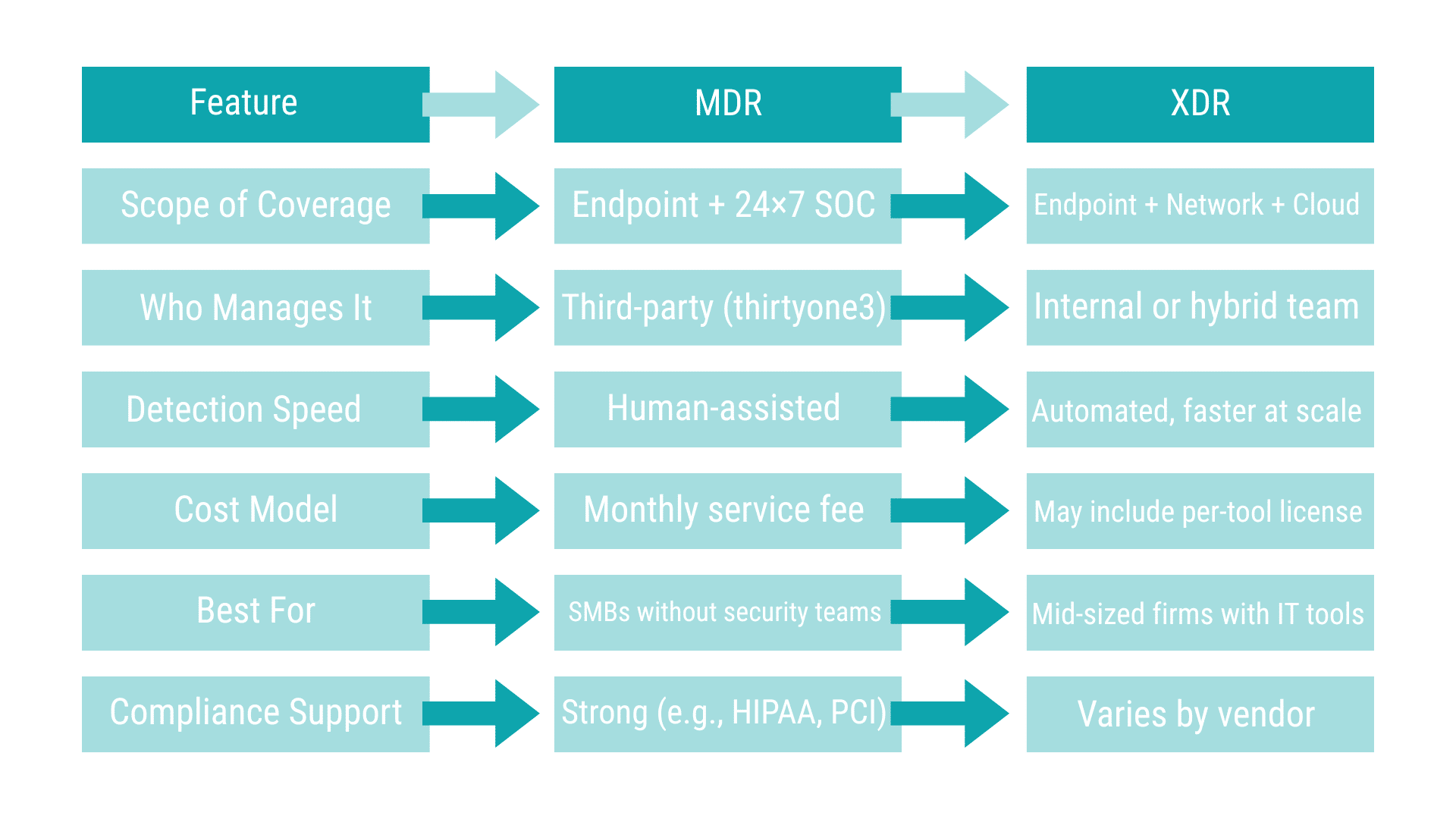Ransomware doesn’t care that you’re a 20-person law office in downtown Phoenix or a fast-growing healthcare provider with limited IT support. Cyber threats are no longer just targeting enterprise giants.
Today, small and mid-sized businesses (SMBs) in the Phoenix Metro area are among the most targeted sectors for cyberattacks. And the stakes are high. A single breach can cost tens of thousands in recovery costs, lost revenue, and compliance penalties.
In an environment where threat actors move faster than ever, relying on traditional antivirus software or periodic firewall checks just doesn’t cut it. Continuous, real time threat detection and response has become essential for professional services, healthcare providers, financial firms, and tech startups alike.
That’s where thirtyone3 technology steps in. We help Phoenix based businesses detect threats before damage is done, respond within minutes, and stay compliant with HIPAA, PCI DSS, and other industry standards.
Whether you’re a practice administrator at a dental clinic or a managing partner at an advisory firm, our managed detection and response offerings are tailored to your operational realities and compliance needs.
What Is MDR?
MDR vs XDR: What Makes MDR Unique
Managed Detection and Response (MDR) is a fully outsourced cybersecurity service that provides 24-hour threat monitoring, detection, and response. Unlike traditional antivirus or managed firewall services, MDR is designed to go beyond prevention. It actively hunts for threats, investigates suspicious activity, and responds to incidents in real time. No internal security team required.
How MDR Works for Modern Businesses
At the core of MDR is a blend of technology and human expertise. The service typically includes endpoint detection agents, behavioral analytics, and a team of security analysts who work in a Security Operations Center (SOC). These analysts monitor alerts, investigate anomalies, and take action. This could include isolating a compromised device or guiding your staff through threat remediation.
Why Phoenix SMBs Choose MDR Over XDR
For small businesses across the Phoenix Metro including solo law offices, dental practices, and real estate brokerages, MDR is a game changer. These organizations often lack the budget or personnel to build their own SOC but still face the same level of cyber risk as larger firms. With MDR, they get enterprise grade protection without the enterprise headcount.
Phoenix Use Case: MDR at a 10 Person Dental Clinic
- Rapid deployment with minimal configuration
- Continuous monitoring by cybersecurity experts
- Automated response actions to contain threats
- Compliance ready logs and reporting for HIPAA, PCI, and more
MDR is especially valuable for industries where security and compliance are mission critical but technical resources are limited. If your team cannot afford downtime or regulatory fines, MDR brings peace of mind with predictable monthly costs.

What Is XDR?
MDR vs XDR Comparison: How XDR Expands Threat Coverage
Extended Detection and Response (XDR) is a cybersecurity approach that integrates data from across your entire IT environment. This includes not just endpoints, but also cloud services, email, identity platforms, and networks.
Unlike MDR, which is often focused on endpoint protection and managed externally, XDR is typically deployed by businesses that already have some level of internal IT or security operations.
The goal of XDR is correlation. It collects security signals from multiple tools and connects the dots automatically, helping you detect and respond to advanced threats faster and with better context.
How XDR Works in a Unified Environment
XDR platforms unify telemetry from disparate sources. For example, an attempted login from a suspicious IP address might correlate with abnormal file access on a cloud drive and an unrecognized process running on a laptop. On its own, each signal might be ignored. But XDR connects them into a single alert, reducing noise and enabling quicker action.
Many XDR systems also include automated response capabilities such as quarantining affected systems or disabling compromised accounts. The emphasis is on speed, scale, and reducing manual investigation time.
Who Benefits Most from XDR in Phoenix
XDR vs MDR: Value for Growing Firms
While MDR is ideal for businesses with no internal security team, XDR gives growing firms more flexibility and control. It allows your team to maintain ownership of the environment while benefiting from improved threat detection and response speed.
That said, XDR is not plug and play. It typically requires upfront integration, configuration, and ongoing tuning to deliver full value. For that reason, many Phoenix SMBs exploring XDR begin with a readiness assessment through a local partner like thirtyone3 technology.
Key Advantages of XDR for Hybrid Teams
- Broad visibility across endpoints, cloud, identity, and network
- Automated detection that reduces alert fatigue
- Integrated threat context from multiple tools
- Scalable as your security operations mature
XDR is a powerful next step for firms transitioning from reactive to proactive cybersecurity. When implemented effectively, it empowers IT teams to stop threats before damage is done.
Key Differences Between MDR and XDR
While both MDR and XDR help businesses detect and respond to cyber threats, they are built for different environments, teams, and business goals. Below is a detailed comparison of the most important differences in how each approach works, who manages it, and what you can expect in terms of coverage, speed, and cost.
Key Takeaways for Phoenix Businesses
- Choose MDR if your team needs hands off, audit ready cybersecurity with expert oversight
- Choose XDR if your team has existing tools and wants deeper, faster insights into threats
- For highly regulated industries, MDR with built in compliance mapping is often the safer path
- XDR offers broader visibility but may require more internal expertise and management
Both solutions help Phoenix businesses stay protected in a complex threat landscape. The right choice depends on your team’s structure, risk tolerance, and compliance requirements. To see how we help clients align security investment with business goals, check out our insight on Essential Tips for Developing an Effective IT Strategy.

Pros and Cons at a Glance
When comparing MDR vs XDR, each solution brings strengths and trade offs depending on your business size, IT maturity, and security goals. Use this breakdown to help determine what aligns best with your operational needs.
MDR Pros
- Fully managed service by external experts
- No internal security expertise required
- Ideal for small teams with tight budgets
- Fast deployment with minimal configuration
- Includes compliance ready reporting for HIPAA, PCI DSS, and more
MDR Cons
- Limited internal visibility or customization
- Relies on a third party for incident response
- May not integrate with all existing tools or platforms
XDR Pros
- Broad visibility across endpoints, cloud, and networks
- Automated correlation for faster detection
- Integrates multiple tools into a single dashboard
- Enables proactive threat hunting by internal teams
- Scales with your business as it grows
XDR Cons
- Requires internal IT or security resources
- More complex to implement and maintain
- Varies widely in features depending on the vendor
- May need custom integration for legacy tools
This quick view is designed to support decision makers in evaluating whether MDR or XDR aligns with their business goals. If your team wants turnkey protection with compliance reporting, MDR likely fits. If you are expanding your security footprint and need deep visibility, XDR could be the right move.
A Decision Guide to Which Is Right for Your Business
Choosing between MDR vs XDR is not about which is better on paper. It comes down to your team size, in house expertise, compliance responsibilities, and business priorities. Below are three common Phoenix business scenarios to help you make the right call.
MDR vs XDR for Businesses Without an Internal Security Team
Best Fit: Managed Detection and Response (MDR)
If you are a small business without a dedicated IT or security team such as a 10-person law office in Scottsdale or a dental clinic in Chandler, MDR delivers 24-hour threat monitoring and response with no internal resources required.
It provides plug and play protection, expert analysis, and audit ready reporting at a predictable monthly cost.
MDR vs XDR for Businesses with Existing IT Tools
Best Fit: Extended Detection and Response (XDR)
If your business already uses tools like Microsoft 365, SentinelOne, or Cisco Meraki, and you have an IT manager or part time SOC, XDR brings these systems together in one unified platform.
A 50-person engineering or architecture firm in Phoenix, for instance, can gain faster detection and deeper visibility without sacrificing control over its environment.
MDR vs XDR for Regulated Industries Like Healthcare and Finance
Best Fit: MDR with Compliance Reporting Built In
If your business operates under HIPAA, PCI DSS, FINRA, or similar regulations, MDR is often the safest route. With compliance mapping and automated reporting included, your team stays inspection ready without added stress.
This approach is ideal for clinics, brokerages, and legal offices across the Valley that need to meet audit requirements without overburdening their staff.
Conclusion
Understanding the difference between MDR vs XDR is key to building the right cybersecurity foundation for your business.
MDR provides around the clock monitoring, expert response, and audit ready compliance support with minimal internal effort. It is the right fit for smaller teams or regulated industries that need reliable protection without technical complexity.
XDR brings automation, deeper visibility, and greater control to businesses with internal IT resources and existing tools. It works best for mid sized firms ready to take a more proactive approach to cybersecurity.
thirtyone3 technology is committed to helping local businesses in Phoenix navigate complex security choices with clarity. From small practices to growing firms, we deliver solutions that support your mission, protect your clients, and scale with your future.

